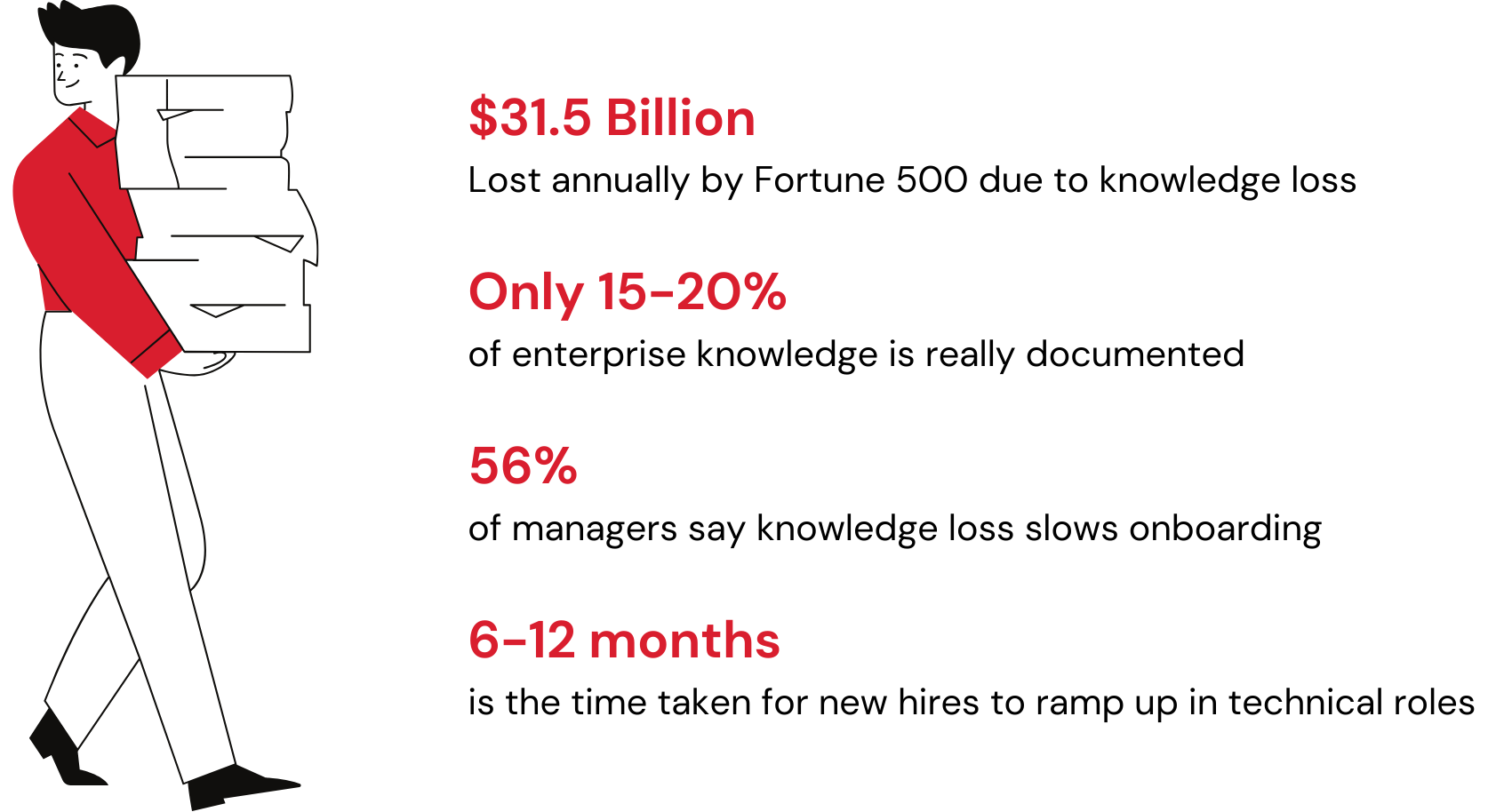Knowledge Is Walking Out the Door — And Most Companies Don’t See It
From retiring engineers to high turnover in support teams, organizations everywhere are grappling with the loss of critical expertise. And while many recognize the need to “capture” knowledge, few realize the true scope of what’s being lost — or the hidden costs it carries.
Hidden knowledge loss isn’t just about losing documentation. It’s about the erosion of decision-making speed, onboarding effectiveness, innovation velocity, and workforce productivity. And it’s accelerating.
It’s Not Just Retirements — It’s Complexity
The systems we work with are more advanced, automated, and integrated than ever before — but that complexity comes with a price:
- More exceptions to handle
- More data to interpret
- More tools and disconnected platforms
Each new layer of complexity demands more contextual knowledge — not just static documentation, but how to solve issues in real-world scenarios. When that know-how disappears, the cost of mistakes, rework, and slow resolutions compounds quickly.
The Numbers Are Staggering

Documentation Isn’t Enough (And Everyone Knows It)
Companies have responded by investing in wikis, training libraries, and AI-powered search tools. But the results often fall flat:
“We built a central knowledge base, but no one uses it.”
“We record training sessions — but they sit in folders no one opens.”
“We bought a chatbot. It answers FAQs, but it doesn’t solve anything.”
The problem isn’t access. It’s activation. If knowledge isn’t embedded in workflows, updated regularly, and made actionable — it gets ignored.
High Turnover, Temporary Teams & Hidden Costs
Today’s workforce is fluid. Cross-functional, project-based, and often hybrid. But knowledge continuity doesn’t follow this flexibility, instead:
- Onboarding takes longer
- Support tickets escalate unnecessarily
- Employees rely on colleagues — not systems — for answers
And here’s the hidden cost:
Senior engineers spend up to 40% of their time on internal coordination, knowledge transfer, and repetitive questions. That’s time not spent on innovation, complex problem-solving, or strategic work. And most companies aren’t tracking it.
“These silent productivity drains are often mistaken as “normal business operations” — but they’re signs of a failing knowledge strategy.”
The Hidden Cost of Inaction
When knowledge isn’t retained or applied efficiently, the impact shows up everywhere:
- Operational Cost: Hours wasted on repeated inquiries and rework.
- Time to Resolution: Service slows down, tickets pile up.
- Innovation Velocity: Experts stuck solving old problems instead of innovating.
- Onboarding Delays: New hires take months to reach full productivity.
- Slow Decision-Making: Tribal knowledge bottlenecks key decisions.
And it’s getting worse as systems grow more complex and talent becomes harder to retain.
But We Already Invested in Tools… Why Isn’t It Working?
Organizations are pouring money into tools — but many still don’t see the expected outcome. Here’s why:
“We are beginning an evolution from knowledge-based, gen-AI-powered tools—say, chatbots that answer questions and generate content—to gen AI–enabled ‘agents’ that use foundation models to execute complex, multistep workflows across a digital world. In short, the technology is moving from thought to action.”
What Companies Really Need: Activated Knowledge
The next frontier isn’t storing knowledge — it’s embedding it, updating it, and turning it into automated support.
This is the shift from archiving knowledge to activating knowledge.
Conclusion: The Problem Is Bigger Than You Think
Knowledge loss is no longer a passive HR issue. It’s a strategic operational risk — one that affects performance, cost, and long-term competitiveness.
The combination of skilled labor shortages, rising complexity, and static knowledge tools is creating a perfect storm. And companies that don’t evolve their approach are falling behind.
📌 The next article in this series will explore how to close the execution gap:
“AI Workforce Augmentation – Moving Beyond AI Assistants to Intelligent Execution”
🧠 What hidden knowledge costs have you seen in your organization?
Let’s talk — or subscribe to our updates for real-world insights on building an AI-powered workforce.






